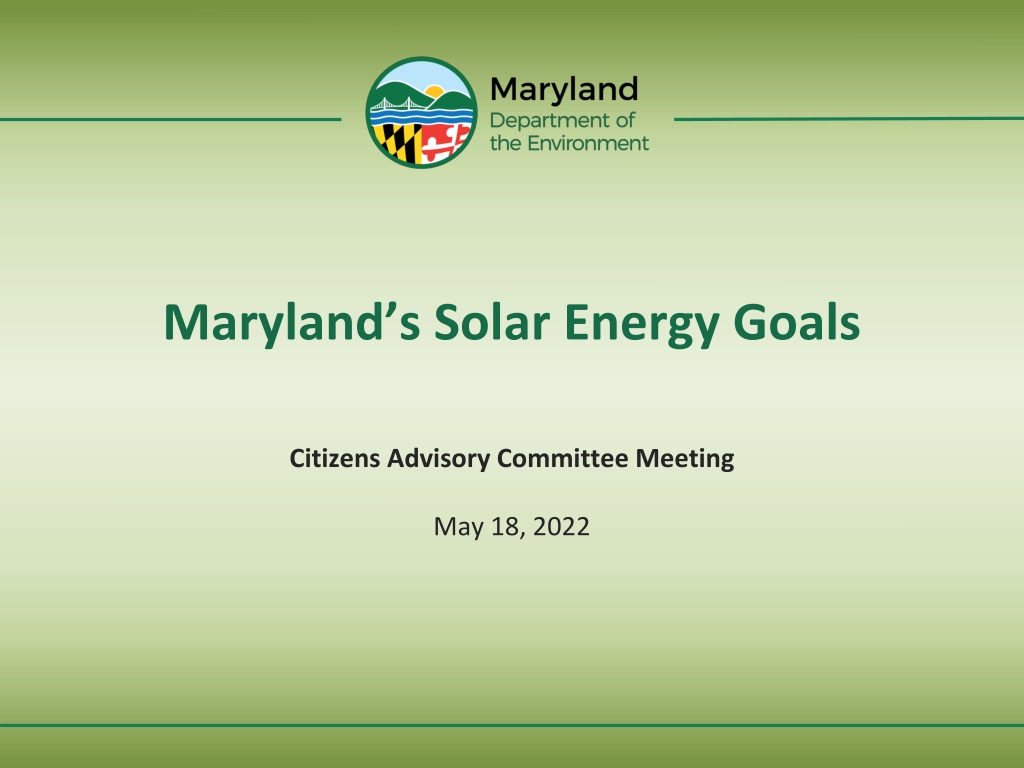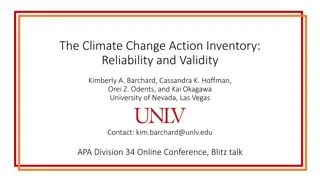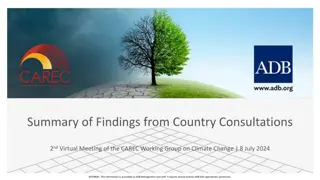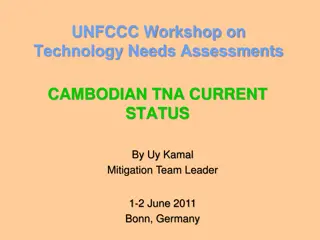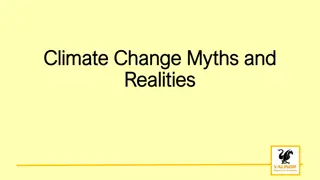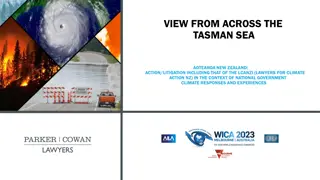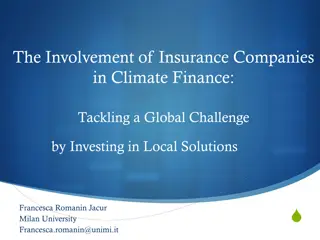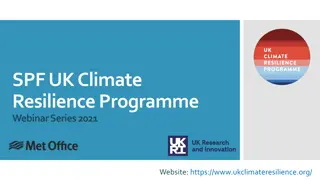Maryland's Climate Change Initiatives and Goals
Addressing climate change has been a major focus in Maryland for over 15 years, with efforts including the Greenhouse Gas Emissions Reduction Acts, the Maryland Commission on Climate Change, partnerships for regional collaborations, and legislation like the Climate Solutions Now Act of 2022. The state's ambitious goals aim to reduce greenhouse gas emissions, adapt to climate change impacts, and work towards a healthier economy while creating new jobs.
Download Presentation

Please find below an Image/Link to download the presentation.
The content on the website is provided AS IS for your information and personal use only. It may not be sold, licensed, or shared on other websites without obtaining consent from the author. Download presentation by click this link. If you encounter any issues during the download, it is possible that the publisher has removed the file from their server.
E N D
Presentation Transcript
Marylands Solar Energy Goals Citizens Advisory Committee Meeting May 18, 2022
Tools to Fight Climate Change in Maryland Addressing climate change is a major priority in Maryland and has been for over 15 years There are now FIVE key areas of focus: 1. The Greenhouse Gas Emissions Reduction Acts (GGRA) of 2009 and 2016 2. The Maryland Commission on Climate Change (MCCC) 3. Partnerships and Regional Collaborations RGGI, ZEV MOU United States Climate Alliance, etc. 4. Pushing back on Federal backsliding 5. Climate Solutions Now Act of 2022
Maryland Commission on Climate Change (MCCC) Original Climate Change Commission established through executive order in 2007 - Developed a 2008 Climate Action Plan that led to the 2009 GGRA MCCC codified into law in 2015 Established a balanced, bipartisan Commission Representatives from the General Assembly, state and local government, the private sector, environmental advocacy groups, labor, the general public & more Basic charge of the MCCC: Provide recommendations on how to reduce GHG emissions and adapt to the impacts of climate change Four Working Groups: Mitigation Adaptation and Resiliency Scientific and Technical Education, Communication, and Outreach
Climate Change Legislation History Climate change effort originated in 2007 by Executive Order (2008 Climate Action Plan ) Resulted in the Greenhouse Gas Emission Reduction Act of 2009 MDE generated a 25% by 2020 Plan GGRA reauthorized in 2016, adding a new goal 40% GHG reduction by 2030 In 2021, MDE submitted a comprehensive plan for a 40% reduction by 2030 April 2022, the Climate Solutions Now Act became law CNSA requires a Plan for a 60% by 2031 and Net-zero by 2045 Both the GGRA and CSNA require that the State s GHG Plans support a healthy economy and create new jobs
The 2030 GGRA Plan The Climate Action Plan includes existing and new programs - across all levels of government Maryland greenhouse gas emissions, accounting for sequestration. Projections from Draft Plan and 2030 GGRA Plan.
Climate Solutions Now Act of 2022 Most Ambitious Near-Term Goal in U.S.: 60-by-31 And Net Zero by 2045, consistent with other leaders
Overview: to Inform the Discussion 1. What are MD s renewable energy goals? 2. What/who are the local drivers in MD? 3. How will MD balance these goals with land use change and water quality impacts? 4. What new guidance has MD issued based on what you ve learned about large scale solar development?
Marylands Renewable Energy Goals The Clean Energy Jobs Act (CEJA) establishes that 50% of MD s electricity shall come from renewable energy resources by 2030 Includes a commitment to examine ways to achieve 100% clean electricity by 2040 CEJA builds upon the renewable portfolio standard (RPS) which is the primary statutory obligation that increases electricity generation from renewables Renewable energy generators will enter a market and supply renewable energy credits Specifically, CEJA sets a new requirement for solar arrays to produce 14.5% of electric power by 2030, up from the current goal of 2.5% by 2020
Update Renewable Portfolio Standard The RPS requires electrical suppliers to provide a percentage of sales from Maryland-certified Tier 1 and Tier 2 renewable resources to reach 50% by 2030 In 2021, SB0065 changed Maryland s solar carve-outs from 2022-2029 The 2030 14.5% solar carve-out remains
What are the local drivers of RE? Incentives and Tax Credits Ambitious economy-wide GHG Targets Remove Obstacles during Project Planning/Permitting Supportive Legislation Expansion of the Net Energy Metering Cap
Smart Incentive Programs The Maryland Energy Administration (MEA) implements several programs funded by the Strategic Energy Investment Fund to provide grants for renewable energy projects Incentive programs enable cost effective solar development and consider land-use and land conservation SB0860 (2022) passed into law providing a tax incentive to encourage community solar energy generating systems on: rooftops, brownfields, landfills and clean fills agrovoltaics
Remove Obstacles for Local Jurisdictions Each county in Maryland has the authority to plan and regulate its own land use but the development of new generation must be approved by PJM PJM administers the interconnection of all regional electricity generation projects A significant portion of Maryland s proposed solar projects (listed in the PJM Queue) on the Eastern Shore The solar projects in operation took an average of 3 years from entering the PJM Queue to coming on-line Proposed solar projects on the Eastern Shore are projected to take up to 8 years
Increase the Cap on net-metering The Maryland Public Service Commission issued a report in November of 2020 on the status of net energy metering in Maryland The Commission recommended that the General Assembly begin to explore expanding the current net metering cap or alternative replacement policies. Expansion of the Net Energy Metering Cap Net energy metering has been a part of Maryland energy policy since 1997 In 2021, the net metering cap was increased from 1,500 MW to 3,000 MW The doubling of the cap will encourage the adoption of distributed generation assets Property owners are incentivized to invest in behind-the-meter electricity generation assets like rooftop and community solar
Cleaner Air from Renewable Energy Transitioning away from fossil fuel fired electricity generation to renewable energy has a measurable impact on water quality in the Chesapeake Bay watershed Atmospheric NOx deposits to tidal waters Indirect deposition occurs when airborne NOx is not assimilated by the land https://www.chesapeakebay.net/news/blog/clean_air_act_improves_water _quality_in_chesapeake_bay
How will MD balance these goals with land use changes and water quality impacts? Maryland Agricultural Land and Solar Generation For utility-scale solar developers, Maryland s agricultural land is a convenient option More than 30 solar generation facilities are currently under construction or review by the state, and a vast majority will be located on agricultural lands From a developer s perspective, the availability of large tracts of open land, which is more common in rural communities, is ideal as it generally does not require extensive site work (e.g., grading, or clearing), particularly if located within proximity to a power substation. Natural and Working Lands provide critical ecological benefits such as water quality and carbon sequestration The Maryland Public Service Commission (PSC) coordinates the CPCN* review process that requires state agencies to examine the costs and benefits of utility-scale solar (>2 MW) on agricultural land * Certificate of Public Convenience and Necessity (CPCN) allows someone to construct new generating station
Protecting Agricultural Lands The state s primary instrument for conserving farmland is the Maryland Agricultural Land Preservation Foundation (MALPF) Maryland Department of Agriculture purchases agricultural preservation easements restricting development on farmland and woodland Created in 1977, MALPF is one of the first of its kind and has become one of the nation's leaders in agricultural land preservation Its mission is to protect the best quality farms and expand on existing preservation areas to increase the size of contiguous blocks of preserved farmland
Maryland's Forest Conservation Act and Solar Generation Protecting Forested Land: Maryland enacted the Forest Conservation Act (FCA) in 1991 that requires that any project that disturbs more than 40,000 square feet must comply with the county implementation statutes The Act established standards for land development to consider conservation in the project planning process County and municipal governments are responsible for making sure these standards are met but CPCN permits are dependent on FCA compliance
Post-Solar Restoration of Farmland Maryland s CPCN license conditions generally require that once the operating life of a solar facility ends (at least 30 years), the facility must be decommissioned, and land returned to its original condition Also, CPCN license conditions require a detailed decommissioning plan and surety agreement to be filed with the PSC
Guidance on large scale solar development? Governor Hogan signed an executive order in 2019 establishing a task force on renewable energy development and siting (REDS) The Task Force released a final report in August 2020 The report summarized the State s renewable energy siting issues, and in particular, siting on natural and working land
REDS Task Force Recommendations Develop Additional Incentive Programs Consider Options for Updating and Streamlining the CPCN Process Expand Rooftop Solar and Other Preferred Applications by Increasing the Net Energy Metering Cap Accelerate Residential Rooftop Solar Permitting Evaluate New and Existing State and Local Government Facilities and Land for Solar Potential Establish an Offset Requirement for Farmland Development Similar to Maryland s Existing Forest Offset Degraded Lands with Photovoltaic (PV) Potential
REDS Task Force Recommendations Develop SmartDG+ a free online tool to site solar Address Transmission and Distribution Constraints Assess Environmental Justice (EJ) Siting Impacts Develop Streamlined Standard to Review and Approve Energy Storage Projects Expand Efforts to Develop Microgrids in Maryland by Leveraging Solar in the Built Environment Expansion of Maryland Green Registry Promote Complementary Practices Like Agrovoltaics and Pollinator Habitat
Next Steps for MDE CSNA requires MDE to produce a 60% by 2031 Plan Draft Plan due June 2023. Final Plan due December 2023.
Contact Chris Beck christopher.beck@maryland.gov
